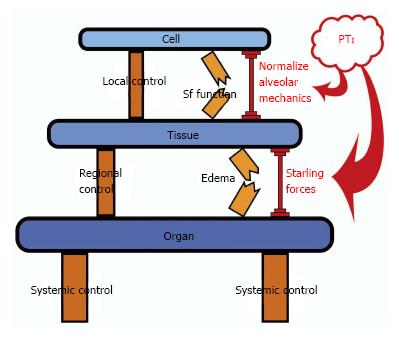Copyright
©The Author(s) 2015.
World J Respirol. Nov 28, 2015; 5(3): 188-198
Published online Nov 28, 2015. doi: 10.5320/wjr.v5.i3.188
Published online Nov 28, 2015. doi: 10.5320/wjr.v5.i3.188
Figure 2 Appropriate mechanical breath settings prevent ‘tipping point’ cascade and acute respiratory distress syndrome.
Control mechanisms at the Local (Cell), Regional (Tissue) and Systemic (Organ) level attempt to balance insults/perturbations such as loss of surfactant (Sf) function and pulmonary edema formation but can fail without additional support. The control systems can be overwhelmed, leading to a cascading effect that culminates in dysfunction at the next higher biologic level (Cell→Tissue→Organ). Current therapies for acute lung injury are applied too late, after the health state has cascaded all the way down to the Organ Level (i.e., development of established-ARDS). We propose that mechanical ventilation modulation strategies with an appropriate pressure time integral (PTI) directed at lower level control structures (i.e., Sf function by normalizing alveolar mechanics and edema prevention by altering the Starling fluid flux forces) early in the failure sequence, prior to complete loss of containment and tipping to the organ level, may help reset the underlying control mechanisms, limit spill-over effects and bolster maintenance of compartmental containment. Application of a preemptive mechanical breath with the proper PTI can assist the endogenous control mechanisms and “shore up” the insults/perturbations to prevent the development of established-ARDS. ARDS: Acute respiratory distress syndrome; PTI: Pressure/time integral.
- Citation: Nieman GF, Gatto LA, Habashi NM. Reducing acute respiratory distress syndrome occurrence using mechanical ventilation. World J Respirol 2015; 5(3): 188-198
- URL: https://www.wjgnet.com/2218-6255/full/v5/i3/188.htm
- DOI: https://dx.doi.org/10.5320/wjr.v5.i3.188









